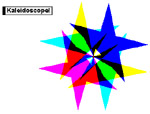Activities
Back to the IntroductionOn this page you can read about activities, download individual sketches, or download the entire collection of sketches, handouts and Teacher Notes. You are free to photocopy these activities for use in your own classroom. You are also free to make changes to the sketches themselves to suit your own needs; but please be sure to save them under different filenames so you don't confuse them with the original sketches. The activities' notes and sketches are Copyright 2003 KCP Technologies. All other rights reserved.
These sketches require Sketchpad 4.0 or later. Many of these documents contain multiple pages. If you have difficulty downloading these sketches individually by clicking on them, consider downloading the entire collection, or right-click (Windows) or Ctrl+click (Mac) their links and choose Download Link To Disk or its equivalent. For more information, read about configuring your web browser.
The Whole CollectionIf you know you want to use several activities from this page, you may want to download the entire collection. This is recommended, as this compressed folder includes all of the Sketchpad documents as well as a PDF file of printable handouts and Teacher Notes to go along with the sketches. Download: syl_booklet_2003.zip |
GroupingGrouping I: The goal of this activity is twofold. First, it introduces students to Sketchpad's most important tools and menu commands. Second, it helps students appreciate how grouping objects can make them easier to count, and how the same quantity of objects can be grouped in different ways. In addition, it will help you developed a classroom vocabulary that can be used in Grouping II. Grouping II: The idea of this activity is for students to appreciate how grouping objects can make them easier to count, and how the same quantity of objects can be grouped in different ways. Younger students might be encouraged to think about how to group objects "evenly," that is, into group sizes that are factors of the total number of objects. The idea that n groups of m is the same as m groups of n (the commutative property of multiplication) can also be explored. Older students might be encouraged to explicitly consider the remainder objects--that is, the number of objects left over after they have been divided into certain group sizes.
Download: Grouping.gsp | 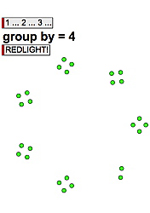 |
Jump AlongThis activity involves a number line along which students observe consecutive jumps, controlling both the number of jumps and jump size. This sketch can be used to model basic questions involving the addition and multiplication of whole numbers. Students can also build and explore factor families, creating interesting visual patterns in the process.
Download: JumpAlong.gsp | 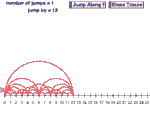 |
Measuring FishStudents use special binker rulers to measure the size of fish. They encounter fish that are not whole number units in length and experiment with the use of fractional parts in order to determine exact measurements.
Download: MeasureFishA.gsp |  |
BalanceThis sketch contains a collection of five different shapes: a star, square, circle, triangle, and diamond. The weight of these shapes can be compared by using the provided balance scale; simply drag one or more shapes onto the balance and it will tilt in the direction of the heavier shape(s).
Download: Balance.gsp | 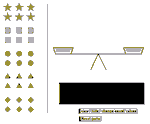 |
Circles and SquaresUsing arithmetic reasoning and logic, players try to determine the secret values of the square and circle in as few turns as possible.
Download: CirclesAndSquares.gsp | 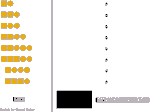 |
Ghost PathsStudents move two ghost characters (Doug and Linda) around the screen to explore geometric concepts. Students discover connections between the ghosts' constructed paths by comparing them and looking for similarities and differences. Vocabulary introduced: line segment, line, ray, circle, radius, hexagon, and octagon.
Download: GhostPaths.gsp |  |
RooBooGooThe idea of this activity is to introduce students to some of the basic transformational behaviors. The emphasis is less on properties than on relationships between objects that have been reflected, rotated, or translated.
Download: RooBooGoo.gsp |  |
SimilarityThis activity introduces students to the important ideas of similarity and congruence. Students create their own re-sizeable logos, which they then use to construct similar shapes. Students can continue to use their logos as signatures for further Sketchpad work, as well as other geometry investigations.
Download: Similarity.gsp | 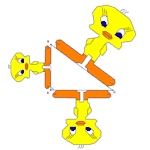 |
Stretching RulerThis set of activities introduces students to mathematical foundations of measurement, and especially to the concept of the unit of measurement. Students create their own rulers to measure different objects.
Download: StretchingRuler.gsp | 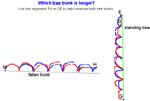 |
Curved PathThe mathematical ideas developed in this activity consist in the iteration of linear units to measure a curved path. The process of constructing a path of a given length can be difficult, even for middle-school-aged students, to perform with accuracy. This environment gives students opportunities to explore the iteration of units along a curved path in a realistic situation by relating the rotation of a wheel to the accumulation of distance units (similar to a trundle wheel).
Download: CurvedPath.gsp |  |
LuluStudents interact with a first-quadrant coordinate system, learning how to specify points though their co-ordinates and to describe horizontal and vertical motion on the grid.
Download: Lulu.gsp | 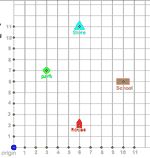 |
Color by NumbersStudents investigate patterns produced on a grid of numbers generated through addition and multiplication of the whole numbers. The focus is on elementary number theory concepts such as even/odd, factors, multiples, divisibility, and the commutativity of addition and multiplication.
Download: ColorNumbers.gsp | 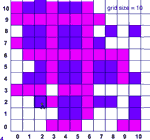 |
